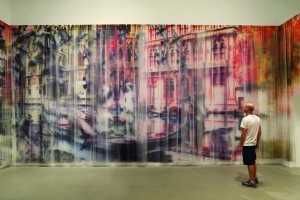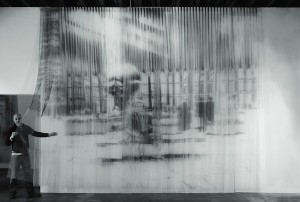(NORTH ADAMS, Mass.) – Izhar Patkin: The Wandering Veil — the long-awaited, much-promised survey of works by the Israeli-born, New York-based artist Izhar Patkin – finally opens in MASS MoCA‘s signature Building 5 gallery on Saturday, December 7, 2013. The exhibition focuses on the internationally renowned artist’s last decade and includes essential works from throughout Patkin’s 30-year career.
The centerpiece of the exhibition is a cycle of spectacular new mural-size paintings on gossamer tulle, which have never before been shown in the United States. The series, Veiled Threats (1999-2010), was inspired by the words of the late Kashmiri-American poet Agha Shahid Ali (1949-2001), with whom Patkin collaborated during the two years preceding Ali’s death. These diaphanous canvases will be draped to create an optically layered, cinematic effect visible through a maze of discrete rooms and from dramatic overhead views within MASS MoCA’s football field-size gallery. In Veiled Threats’ ghostly imagery, Patkin has visually adapted Shahid Ali’s poems, which touch on themes of memory, loss, and exile.
Highlighting formal and technical innovations pioneered by the artist, the show opens with Don Quijote Segunda Parte (1987), a flamboyantly baroque polychromatic anodized aluminum sculpture that alludes to the famous fictional character as well as to the legendary New York Times architecture critic Herbert Muschamp. Taking a cue from this greeting image, the entire show reverberates between myth and savvy commentary on painting, and the world of art and cultural politics.
An example of the artist’s groundbreaking paintings on rubber curtains made in the 1980s, The Maids of Honor, referencing Diego Velázquez’s Baroque masterpiece Las Meninas, will also be on view.
In his paintings, Patkin often turns the surface into a membrane, a porous sieve. The lightly painted, liminal images on the translucent veils float in the air. Patkin thus reproposes pictorial space as a kind of “ghostly threshold,” one that is between representation and manifestation. Whereas for Marcel Duchamp this “infra-thin” space was a mental construct, an aesthetic ideal, for Patkin it is also a physical pictorial space. Patkin’s canvas is not subservient to the image; rather, the image and the support are in a constant state of flux, leaving the paintings suspended in a kind of metaphoric purgatory. Without abandoning painting, the works on view in The Wandering Veil bear affinities with performance art, film, and architectural painting.
In describing his work, Patkin has often referred to the meditatively extended shots in the films of Andrei Tarkovsky and the illusionistic painted rooms of the Renaissance artist Giulio Romano. Patkin’s viewer literally steps into the immersive pictorial space of the painting: as the works insist on the value of the painted image, while refusing traditional image-to-ground convention, challenging both the traditions of painting and those of the pervasive contemporary media of video, performance, and installation art.
Patkin’s early works shared similar preoccupations. In his “reverse paintings” on wire-mesh screens, entitled Gardens for the Global City (1991), which are meditations on the motifs in traditional Asian carpets and the story of Modernist painting, encaustic paint is pushed from the back of aluminum netting, filling the open weave to create the canvas.
In one of these works, Unveiling of a Modern Chastity (1981) – Patkin’s premonition of a calamitous plague – the canvas becomes a wounded skin, with the raw pink interior bulging out through the utopian promise of the modernist flat surface. In another series, Palagonia (1990), large photographs of lace and wax figures, the photographically printed paper has been mechanically perforated, again turning the paper into veil-like tissue.
The Wandering Veil presents several overarching grand narratives that evoke loss and exile at the most intimate scale, including a childless Madonna, a Shiva who has banished himself from a garden, an Ark of the Torah morphing into a donkey, and a Don Quixote gazing at his fictional nature reflected in a mirror-all archetypes confronting their own suspended reality.
As an emigrant who is navigating various changing cultural realities, Patkin has commented that he is as weary of globalism as he is of heightened nationalism. For him, we are – like his paintings – veils in a landscape, alternately hiding and revealing.
From his early Meta Bride (1982), a black bride with a Snow White complex, to his enigmatic and cinematic Veiled Threats, The Wandering Veil creates a dreamlike architectural space, a place of impermanence in which the body, along with painting, comes face to face with its own myth.
The exhibition, co-organized by MASS MoCA, travels from the Tel Aviv Museum of Art and the Tefen Open Museum, where it premiered last year.
Izhar Patkin: The Wandering Veil is supported by Artis and Lynn Holstein with additional funding provided by the Massachusetts Cultural Council.
Izhar Patkin: The Wandering Veil will be accompanied by a lavishly illustrated hardcover book. Essential supplements to the illustrations are the essays and conversations by Herbert Muschamp, Sefi Rachlevsky, Shimon Adaf, Shlomzion Kenan, David Ross, Ellen Ginton, Ruthi Ofek, and Itamar Levy. The book includes poems by Agha Shahid Ali, Mahmoud Darwish, and Faiz Ahmed Faiz. The 300-page volume is published in English and Hebrew by the Tel Aviv Museum, the Tefen Open Museum, and MASS MoCA, and will be available in the museum stores.
MASS MoCA is one of the world’s liveliest (and largest) centers for making and enjoying the best new art of our time, across all media: music, art, dance, theater, film, and video. Hundreds of works of visual and performing art have been created on its factory campus during fabrication and rehearsal residencies in North Adams, making MASS MoCA among the most productive sites in the country for the creation and presentation of new art. More platform than box, MASS MoCA strives to bring to its audiences art and shared learning experiences that are fresh, engaging, and transformative.
MASS MoCA’s galleries are open 11am-5pm every day except Tuesdays. In July and August, MASS MoCA’s galleries are open 10am-6pm every day. Gallery hours are often extended on evenings featuring performing arts events. Gallery admission is $15 for adults, $10 for students, $5 for children 6-16, and free for children 5 and under. Members are admitted free year-round. For additional information, call 413.662.2111 x1 or visit MASS MoCA.


